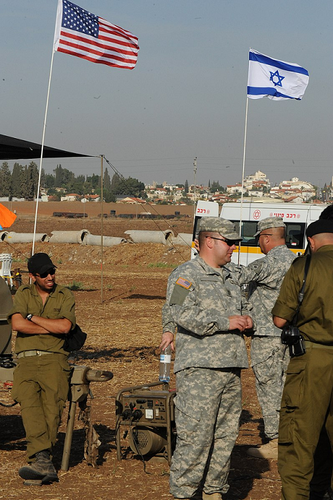
–>
January 27, 2023
The United States and Israel have had a close political and security relationship for decades, because — in the main — they see both democratic norms and the requirement for security as mutually reinforcing. Iran’s willingness to kill its own citizens in the streets and provide military support to Russia’s invasion of Ukraine have brought Washington closer to Jerusalem’s view of the most important and most imminent threat to stability in the region. But it isn’t a smooth transition, as American diplomats are still insisting on defining Israel’s politics in place of and in opposition to Israel’s voters.
‘); googletag.cmd.push(function () { googletag.display(‘div-gpt-ad-1609268089992-0’); }); }
Fortunately, the American military establishment appears not to have let that interfere with its national security mission. The U.S. needs Israel to support American and allied operations.
Israel’s experience with Iranian drone attacks began before Ukraine’s experience with those drones fired by Russian troops. In November 2022, an Iranian Shahed-136 suicide drone attacked an Israeli oil tanker near Oman.
Also in November, General Michael “Erik” Kurilla, commander of U.S. CENTCOM, made his fourth visit to Israel since assuming the position only seven months earlier. This was followed by the U.S. and Israeli Air Forces holding a three-day exercise over the Mediterranean Sea and Israel. “They are practicing fighter escort and aerial refueling,” said a Pentagon spokesman.
‘); googletag.cmd.push(function () { googletag.display(‘div-gpt-ad-1609270365559-0’); }); }
On January 16 and 17, Gen. Kurilla made his fifth visit, with stops at the Israel Air Force HQ and Air Operations Center for “updates on regional threats and opportunities and an overview of integrated air and missile defense.” He also met with Lt. Gen. Herzi Halevi, the new IDF Chief of the General Staff, and Yoav Gallant, the new Israeli Defense Minister.
 That was in advance of this week’s Juniper Oak live fire exercise, including more than 100 U.S. aircraft with fighters, bombers, and refueling aircraft flying alongside 42 Israeli aircraft. The exercise, with more than 6,500 U.S. personnel and nearly 1,100 Israeli personnel participating, covers all the domains of warfare to include space and electronic warfare.
That was in advance of this week’s Juniper Oak live fire exercise, including more than 100 U.S. aircraft with fighters, bombers, and refueling aircraft flying alongside 42 Israeli aircraft. The exercise, with more than 6,500 U.S. personnel and nearly 1,100 Israeli personnel participating, covers all the domains of warfare to include space and electronic warfare.
Previously, from October 2021 — August 2022, there were there at least three major drills leading up to this. First was an air exercise that was a melding of EUCOM and CENTCOM, including the UAE Air Force Commander along with France, Germany, Greece, India, Italy, the UK, and the United States. A Jordanian pilot was there as well, but that was supposed to be a secret.
In February 2022, a massive Red Sea naval drill led by the U.S. Fifth Fleet included Israel for the first time. Countries of the Abraham Accords were there — UAE, Morocco, and Bahrain. But so were Bangladesh, Comoros, Djibouti, Oman, Pakistan, and Saudi Arabia, with which Israel has no formal relations.
In August, there was a joint missile defense test, during which Israel tested its entire defensive array against rockets and ballistic missiles. In parallel, the Americans tested Patriot, AEGIS, and THAAD systems. The simulation was held in a unique testing facility to provide real-time data and enable in-depth debriefing, the Israeli Defense Ministry said.
That brings us to November’s exercise and into 2023. On 1 January, the U.S. deployed six fighter jets to Israel as part of a military tactic to disperse American aircraft to various airbases. They are also there to conduct joint drills with Israel’s fleet of F-35 stealth fighters and a squadron of intelligence-gathering Gulfstream G550 planes, simulating strikes deep in enemy territory, the IAF said.
‘); googletag.cmd.push(function () { googletag.display(‘div-gpt-ad-1609268078422-0’); }); } if (publir_show_ads) { document.write(“
There is a mighty contrast between CENTCOM’s working relations with Israel and the U.S. political echelon’s fixation on two political matters that are, frankly, not Washington’s business.
National Security Advisor Jake Sullivan announced before his January visit, “I’ll be clear on opposing policies that undermine the two-state solution.” Whether or how to achieve two additional states between the Jordan River and the Mediterranean Sea — or even its desirability in light of the weakness of Jordan and the increasing influence of Iran among Palestinian factions plus increased attacks against Israeli civilians — is really a security policy best pursued by the democratically elected government of Israel.
Speaking of which, before Secretary of State Antony Blinken’s visit to Jerusalem, U.S. ambassador Thomas Nides announced that he would talk with his Israeli counterparts about “shared values and the importance of strong democratic institutions.”
Changes to the Israeli judicial system are, again, best left to the democratically elected government of Israel. No Israeli government official — or anyone else in Israel for that matter — had anything to say about Democrats threatening to pack the U.S. Supreme Court when they didn’t get their way.
American analyst David Wurmser noted this week, “The mandate is over, and Israel is sovereign. It needs no lectures on democracy.”
Words to live by as the U.S. and Israel coordinate and cooperate on the real threats to the region: Iran and Russia and their ruthless suppression of rights and lives from Europe through the Middle East.
Image: Israeli Defense Forces
<!– if(page_width_onload <= 479) { document.write("
“); googletag.cmd.push(function() { googletag.display(‘div-gpt-ad-1345489840937-4’); }); } –> If you experience technical problems, please write to [email protected]
FOLLOW US ON
<!–
–>
<!– _qoptions={ qacct:”p-9bKF-NgTuSFM6″ }; ![]() –> <!—-> <!– var addthis_share = { email_template: “new_template” } –>
–> <!—-> <!– var addthis_share = { email_template: “new_template” } –>





